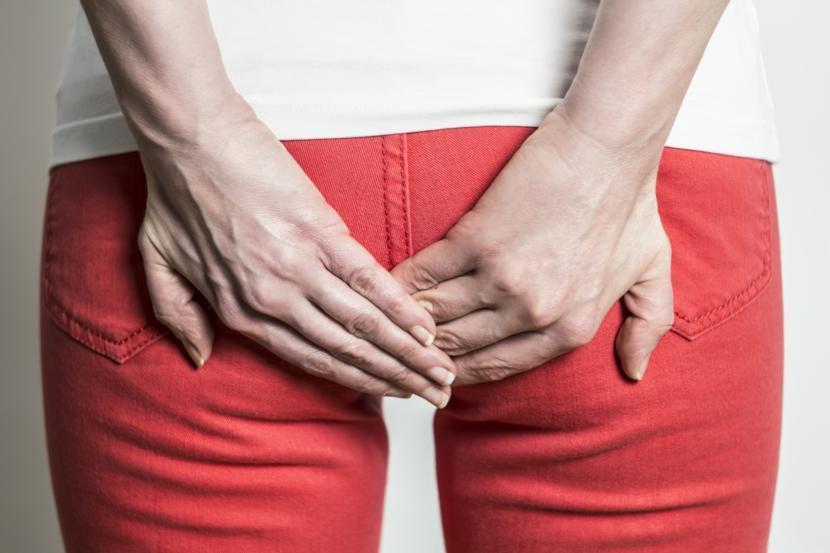What Is a Thrombosed Hemorrhoid?

Hemorrhoids result from the application of pressure in the anus and rectum. This pressure affects the flow of blood, resulting in the formation of swellings in the veins covering these areas, known as hemorrhoids. At times, the vessels may not allow blood to flow properly along these veins and the blood may pool in the hemorrhoids.
This leads to clotting of blood in the hemorrhoids, a condition referred to as thrombosis. A thrombosed external hemorrhoid is due to the rupturing of blood vessels around the anal opening. It causes blood to leak out and forms a clot. It may or may not be accompanied by edema. The cause is sometimes unknown, but it is usually anything that increases the intra-abdominal pressure very quickly, such as lifting, straining, coughing, or pregnancy. Hemorrhoids are also known as piles.
Thrombosed hemorrhoid is a common problem. The risk factors associated with thrombosed hemorrhoids are constipation and traumatic vaginal delivery. A thrombosed hemorrhoid is a painful swelling that occurs in the anal tissues and is usually caused by a clot in one or more of the small veins there. The tissues are usually swollen and quite painful and tender. They have a bluish color because of the underlying clot.
Causes of thrombosed hemorrhoids include:
- Certain foods, especially spicy ones
- Alcohol, tea, or coffee
- A diet with too little fiber
- Too heavy or repeated physical exertion (cycling, motor race, etc.)
- Decreased elasticity of the skin around the hemorrhoid area
- Diseases of the digestive system or liver, which may involve a downstream blood flow
Any excessive pressure exerted on hemorrhoids creates congestion (blood retention).
Thrombosed hemorrhoids are usually very painful. They are notable for their blue or purple color, which is different from regular hemorrhoids; regular hemorrhoids are red or pink.
Thrombosed hemorrhoids are believed to develop from further pressure on the veins in the anal and rectal regions of the body. This can be a result ofconstipation.
People who are constipated spend a lot of time seated on the toilet, and this causes pressure and stress on the veins in the anus and rectum. In addition, since the person is likely to push too hard, the anal and rectal veins will further experience pressure, causing the development of hemorrhoids. Further causes include:
- Too much sitting or standing
- Pushing too hard when in the bathroom
- Poor posture
- Diarrhea
- Pregnancy
To reduce the chances of getting hemorrhoids when pregnant, you should drink sufficient water every day (8 to 10 glasses a day is normally advised). Drinking enough water will help prevent constipation and make stool softer.
Treatment of Thrombosed Hemorrhoids
Treatment of thrombosed hemorrhoids is done using certain medical procedures. This is necessary, because the condition is very painful and can disable the patient from performing certain day-to-day responsibilities; going to the bathroom can even become a problem. The treatment options available for thrombosed hemorrhoids are:
- Surgery: This is referred to as a hemorrhoidectomy. The procedure involves the complete removal of the thrombosed hemorrhoids.
- Injection: Thrombosed hemorrhoids are injected with a certain solution, which makes them wither and die.
- Band litigation: The thrombosed hemorrhoids are choked using a rubber band, which prevents them from receiving any blood, eventually causing them to die.
- Burning: Hemorrhoids are burned using infrared lights, laser beams, or electrical coagulation.
The doctor would first try an injection or the band litigation technique. Both these techniques are known as fixative procedures. As a last resort, if the hemorrhoid becomes severe, the doctors will opt for a hemorrhoidectomy.
Taking anti-inflammatory pain medication such as naproxen, ibuprofen, and Tylenol reduces the discomfort to a certain level. One can also increase fiber intake and take warm baths or soak in warm water (also called a sitz bath), as well as make use of stool softeners. The pain and swelling should subside in a few days, but the lump could take two to three weeks to go away completely.
A sitz bath allows a major practice of comprehensive anal hygiene. The warm water soothes the inflamed spot and thus reduces the pain and swelling. If strangulation is making it difficult to sit, one can practice squatting in the warm water, several times a day, for at least twenty minutes each time. During bowel movements, stool softeners help ensure less straining occurs while passing stool.
Ice can also be applied to the anus, which will restrict the blood supply to the hemorrhoid. This in turn produces numbness in the inflamed region, which provides relief from the pain. To apply ice, first wrap the ice-pack in a clean cloth towel; wait a few minutes, then apply directly to the anal opening.
Increasing metabolism is also a major factor for reducing hemorrhoid symptoms. Try increasing daily physical activity, for example, walking a minimum of 30 minutes a day. This should be a habitual practice.
The bulk of therapies on the market use artificial chemical substances to alleviate aches and itching, but this provides only temporary relief. Numerous people report this kind of option does not really work. Organic treatment therapies can help get rid of this issue as well as address the cause and generate better blood flow to your veins, resulting in fewer flare ups. Herbal medications are also successful for treating symptoms of thrombosed hemorrhoids. Nonetheless, you should take actions to treat the problems that lead to the condition.
There are many treatment options for hemorrhoids, primarily depending on the stage of the condition. You can treat hemorrhoids by alternative methods, however, you should always consult your doctor before trying any of these treatments. If you wrongly treat the condition, it can advance to severe forms. These alternative treatments include the application of witch hazel, Ruscus aculeatus, apple cider vinegar, coconut oil, aloe vera, orrutin.
To prevent the development of thrombosed hemorrhoids, it is necessary to treat hemorrhoids early, before they become thrombosed. These are some of the symptoms of hemorrhoids:
- Itchiness in the anal region
- Pain in the anal region
- Blood in the stool
- Presence of lumps in the anus
If you have one or more of these symptoms, you should go for a medical examination to determine whether or not you have hemorrhoids. This is important, because hemorrhoid treatment needs to begin early. Otherwise, you risk developing thrombosed hemorrhoids.
Of course, you may not see all of these symptoms. They vary from person to person, and are also determined by the severity of the condition. Blood in the stool can be noted during visits to the bathroom. You can treat the condition using available home treatment options. In the early stages, hemorrhoids rarely require more than alternative treatment.
To prevent the development of hemorrhoids, include lots of fiber and water in your daily diet. These two components will improve your digestion and soften your stool, preventing constipation. Constipation is among the most common causes of hemorrhoids. In fact, constipating when you already have hemorrhoids has been noted as one of the causes of thrombosed hemorrhoids. It is therefore important to include water and fiber in your diet. In addition, you should always have an upright posture. Make a regular routine of stretching exercises, as these will improve the flow of blood in the lower part of the body. This is especially important if your daily life involves too much sitting or standing.
One should make a note of the following once you undergo incision and drainage for hemorrhoids:
- Activity should be reduced for the next 12 to 24 hours post-incision; no major or minor activity. The person may expect minor bleeding for a day or two after the procedure, but that is normal.
- The initial dressing done on the day of the incision can be removed after 12 or 24 hours.
- If you need to move your bowels before the dressing is removed, you can remove the dressing at that time; it can be later replaced with a plain cotton gauze to absorb the drainage.
- You can take a warm shower or sit in a tub filled with warm water for 15 to 20 minutes for some relief. This will also maintain cleanliness in the area.
- Diet should be regular and include lots of high fiber and green veggies. Reduce your intake of caffeinated drinks and increase that of non-caffeinated fluids. Drink at least six to eight glasses of water per day to avoid constipation.
- Ensure to take your medications in a timely manner. They will be mostly pain relievers. Avoid taking medications on your own, since some medicines increase the chance of constipation.
Causes for Concern Post-Hemorrhoid Surgery
Immediately inform your doctor if you experience any of the following:
- Difficulty urinating
- Pain has not subsided and even increased
- Excruciating pain which is not relieved even with pain medication
- Sudden fever and chills
- Nausea and vomiting
- Watery diarrhea within 24 hours
- Going more than three days without a bowel movement, leading to constipation
- Severe bleeding
What Is the Difference Between Internal, External, and Thrombosed Hemorrhoids?
An internal hemorrhoid is a swollen blood vessel that arises from within the rectum and above the pectinate line. There are no obvious symptoms of an internal hemorrhoid unless one starts to have bleeding with their bowel movements, or if it prolapses. This can be felt externally after it protrudes through the anus.
When the blood vessels surrounding the anus expand beyond the pectinate line, this is an external hemorrhoid. It isn’t much of an issue unless it rapidly enlarges and clots. The clot resolves, leaving residual skin.
If the blood clot does not resolve, it leads to a thrombosed hemorrhoid, which causes excruciating pain at times and swelling within the hemorrhoid tissue.
Preventing Thrombosed Hemorrhoids
There are a variety of ways to prevent thrombosed hemorrhoids, including:
- Specific changes in lifestyle
- Dietary changes, including fiber-rich foods
- Consume more fluids and avoid caffeinated drinks
- Practice better posture to avoid any pressure on the pelvic region
- Daily exercise or carrying out physical activity that avoids unnecessary strain on the body
- Avoid strain during bowel movements
- Avoid intake of laxatives
- Take witch hazel, which is known to reduce pain, bleeding, and itching, as it contains tannin and oils that help reduce inflammation, slow bleeding, and tighten the skin.
- Use aloe vera in its pure form to soothe inflammation caused by a hemorrhoid
- Avoid foods that cause constipation and diarrhea
- Wear loose-fitting clothes and undergarments to ease symptoms such as irritation, pain, and swelling
- Pregnant women are more prone to hemorrhoids, so they should practice Kegel exercises, under supervision, to strengthen muscle tone in the rectal area
No one is responsible for your health except you. Hence, proactively bringing certain changes in your lifestyle can make a big difference in keeping illness at bay.
Summary
A thrombosed hemorrhoid is:
- Located on the outside of the anal opening
- Has a blood clot
- Painful and swollen
A thrombosed hemorrhoid is caused by:
- Weak veins
- Poor blood circulation
- Inability to empty bowels
- Inflammation













